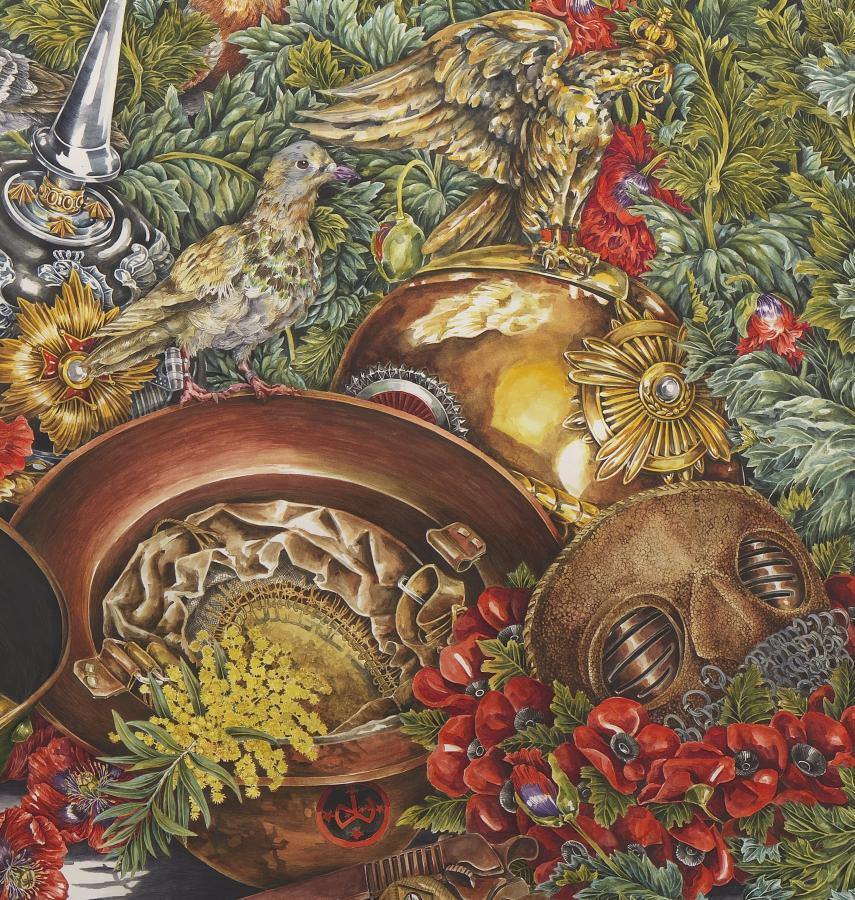Cure for pain
Part 1: Helmets & Masks

Measuring just over four metres long, eX de Medici’s painting Cure for pain appears as a garden composed of military helmets and masks, with poppies, roses, and other flowers. Flitting among the flowers, or perched on helmets, are birds, including nightingales, finches and pigeons. Yet, far from an idyllic paradise, these symbols represent over a century of conflict in which Australia has been involved. Acknowledging both enemies and allies, Cure for pain is an expression of our common mortality, and our equality in death. Military hardware has long been a key feature of de Medici’s work, and this prompted her appointment as an official war artist to the Regional Assistance Mission to the Solomon Islands in 2009. De Medici created a body of work that responded to the legacy of colonisation, the impact of the Second World War, and the role of Australian peacekeepers. Cure for pain continues that work as an official war artist, but broadens its scope to encompass Australian military history from the colonial era to the present.
The military helmets evolved from de Medici’s earlier use of the skull, which had been a feature of her watercolours since the late 1990s. However, the proliferation of skulls in popular culture led her to a reworking of this symbol. Skulls had saturated the contemporary art world and had become a useful marketing tool; from highbrow fashion to a print motif on children’s clothes in department stores, the skull had become a trite commodity. The skull had lost the force it once had as a central symbol in 17th century vanitas paintings, where it represented the transience of life and the vanity of human wishes; so de Medici was prompted to evolve the skull metaphor into the representation of a helmet. She expanded on this notion in an interview with the Memorial on 6 May 2010:
The helmet sits at the same point as a skull. It is a skull. It is the exoskeleton of a skull. It’s a mask. It’s an instrument for other purposes that can cloak identity, for instance, which was my first use of it: the disguise of identity in aggressive situations.
That same year, she began a series of watercolours devoted to military helmets, including Cure for pain.
The helmets signify different conflicts in which Australia has been involved, starting on the left of the work with two Australian colonial helmets. These refer to frontier conflicts, but are also representative of Australia’s involvement in early international military conflicts. There are five helmets from the First World War: a black German Pickelhaube; a German trooper’s helmet featuring an eagle; a German steel helmet; an American helmet bearing the badge of the 27th Infantry Brigade; and a British Royal Tank Corps leather and chain-mail face mask. Relating to the Second World War are a green American helmet bearing stars, and a brown Japanese Imperial Army helmet that features the artist’s addition of a white chrysanthemum. There are two gas masks, a blackish one salvaged from Papua New Guinea by a member of the Royal Australian Corps of Military Police, and one other whose conflict is unidentified.

From the post-1945 conflicts there are a khaki-coloured flying helmet with oxygen mask and goggles, and a helmet spray-painted blue that was worn by an Australian peacekeeper during the United Nations Assistance Mission for Rwanda (1993–96). There are also a Browning sidearm, a pistol used throughout the Second World War and into Afghanistan (2001–14), and further along, a Browning holster used in the Vietnam War (1962–75). Two battle helmets belonged to an Australian soldier who served with the Royal Australian Corps Military Police in both East Timor (Timor-Leste) and Afghanistan. One helmet is rendered with the Australian Army Disruptive Camouflage Pattern Uniform in green jungle tones, while the other is in purple and tan for desert operations. Both helmets are fitted with Oakley goggles. Shown in the lower right corner, from two different angles, is a cutaway helmet worn by an Australian Special Forces soldier in Afghanistan. There are also a black respirator used in contemporary conflicts, and a boarding helmet worn during the Tampa crisis in 2001.
The helmets demonstrate the evolution of combat helmet design over more than a century. Like de Medici’s moth studies at the Commonwealth Scientific Industrial Research Organisation (CSIRO), and her ongoing series portraying weapons, these helmets have the appearance of specimens, and remind us of de Medici’s interest in natural history illustrations. In particular, her use of black shadows acknowledges a technique she observed in the drawings of the Austrian-born Ferdinand Bauer, who was the natural history painter aboard Matthew Flinders’s Investigator. Bauer produced elegantly rendered and scientifically accurate depictions of Australian flora and fauna. De Medici’s meticulously drawn helmets reflect her key observations that the helmet is both a mask and a metaphor for a skull, and that it serves as a contemporary vanitas representing death, violence, and commemoration.
Cure for pain was generously gifted to the Memorial, through the Australian Government’s Cultural Gifts Program, by Erika Krebs-Woodward in 2016. Cure for pain is on display for the first time in the exhibition The deceiving eye, located on the Mezzanine Gallery of ANZAC Hall until 11 September 2017.